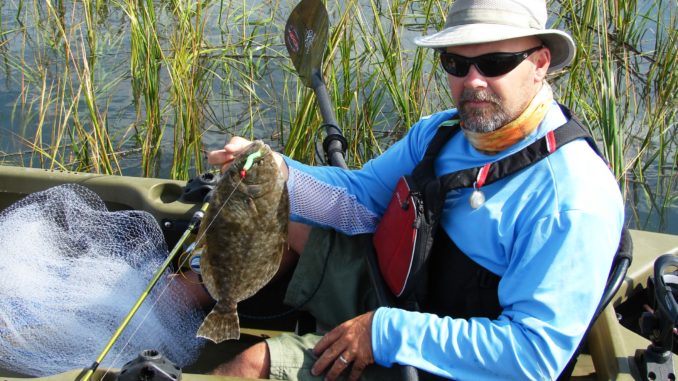
North Carolina’s Fort Fisher is regularly under attack from kayak fishermen.
Mark Patterson believes the bays at Fort Fisher are pretty close to ideal for kayak fishing. A Greensboro resident and founder of the North Carolina Kayak Fishing Association (NCKFA), Patterson fishes the area, which kayakers simply call “The Fort,” numerous times a year.
His opinion is a reasonable one, as the Basin and Second Bay are separated from the Cape Fear River by a jetty-like structure called “the Rocks” that runs about three miles from Federal Point at Fort Fisher to a point in the marsh behind Bald Head Island. Buzzard Bay is the third bay, and while not technically located behind the rocks, it is just a few hundred yards south of Second Bay through a winding creek system that is too shallow for all but the shallowest draft boats.
Creeks run between the bays and the ocean beach, and all of them hold fish at various times. Redfish, flounder and trout are the main draws, but there are also black drum, ladyfish and more. Small sharks and rays cruise the waters behind the Rocks and occasionally there are explosions as schools of jacks attack baitfish they followed into the protected waters.
It is an extremely popular spot for kayakers, and with its diverse water system, it provides plenty of space for them to spread out. Several kayak-fishing organizations have outings and tournaments there, including the NCKFA with its Specks and Spots Tournament that benefits the Heroes on the Water kayak-fishing program in November.
“I really like coming here to fish, and I’m still learning things,” Patterson said. “My first couple of trips, I concentrated on fishing the Rocks, as it is just so obvious. I caught fish, too. However, after several (NCKFA) members from the area began helping me learn the creek system and how good it can be, I began fishing some of the other places and finding fish there, too.
“These bays and creeks really are a special place to fish and are almost ideal for kayaks, Patterson said. “They give us all the benefits of fishing the lower Cape Fear River, but with protection from the wakes of the ships moving up and down the river and strong winds blowing across the river.”
On the morning of one trip, Patterson caught some mullet minnows and small menhaden for live bait. He typically fishes two lines, with one having live bait and the other being a lure he can cast and retrieve to cover more area.
After launching at the ramp at Federal Point, he crossed the Basin to Zekes Island, then turned left into a maze of creeks. Patterson said that if he had a four-wheel drive vehicle and a beach-driving permit, he could drive down a trail between the bays and the beach to one of four access points and begin farther out in the bays, something many paddlers do.
With the tide rising, he positioned his kayak just off a small point at the mouth of a creek, with an obvious current eddy from the tide flowing past. He set his stake-out pole, then hooked a struggling minnow on a bottom rig and cast it just over into the edge of the stronger current. Placing the bait rod in a holder, he began casting a grub to the close edge of the eddy, letting the current sweep it past the mouth of the creek.
“We should know if there is anything here pretty quickly,” said Patterson, a biology major. “Between that minnow struggling on the bottom and this grub being carried by in the current, there should be something to get a hungry fish’s attention. Sometimes the live bait will get a fish’s attention with its struggles, even if they aren’t hungry. It becomes an easy meal of opportunity, and they can’t turn it down.”
A moment or two later, the live-bait rod made a quick dip and a couple of jerks. It caught Patterson’s attention and he cleared and stowed the other line. He carefully slid the rod out of its holder and slowly lifted the tip to tighten the line and make sure the fish was still there without spooking it. The braided line came up tight with pecks of the fish biting resonating up the braid line and twitching the rod tip, so Patterson struck quickly. The rod doubled over, and the reel began singing as the hooked fish decided it needed to vacate the area.
After a few seconds, the fish came to the surface and rolled. Patterson declared it a redfish and struck it again to be sure the hook was set, explaining later that a kayak will sometimes shift a little during the motion of a hookset, and the point wouldn’t be driven all the way in. He counters this by using braided line without stretch, and when he finds the fish to be a red or a flounder, he’ll set the hook again to make sure he drives the point home — not necessary with a soft-mouthed trout, an action, in fact, that might even pull a hook free if it wasn’t secure.
When the tired fish rolled up next to the kayak, Patterson guessed it to be above North Carolina’s 18- to 27-inch slot limit, and he was correct; the fish was 31 inches long on Patterson’s measuring board, and he slipped it back over the side.
The next strike was a flounder that hit the grub. It wasn’t huge, but it made a couple of surges and swung the kayak around on the anchor pin. A few minutes later, it came to the boat, and Patterson decided to invite it home to be the guest of honor for dinner.
Patterson fished the point for a while and caught several black drum, an undersized redfish and several more, but smaller, flounder. When the current started to slow, he moved to near the middle of one of the bays and began watching his fishfinder and GPS. Moving in a small circle, he found what he was looking for and planted his anchor pin.
“This is a spot I found a couple of years ago by accident, but it often holds fish,” Patterson said. “It is an oyster rock in water just deep enough it doesn’t get exposed, even at low tide. The current this far back in here is light, but it is just enough to move some bait across the oyster rock. One side of the rock will have a little current, and the other makes a lee, and different fish will like both. Anchored here off the end, I can cast to both sides and see which they prefer today.”
After just a few casts, Patterson felt a light tic, then had something crush his bait. Reacting quickly, he set the hook, and about 50 feet away, a trout surged and stuck its head out of the water, shaking in a vain attempt to throw the hook.
“Oh man, that trout would complete a slam,” Patterson said. “I need to land it to complete the day.”
The trout was a keeper and Patterson invited it home to keep the flounder company. He caught a smaller trout he released, and then the action slowed. With the tide almost full, Patterson decided he would let the last of the moving water help push him back to the ramp rather than staying later and having to travel against it.
Patterson said the bays and adjoining creeks at Fort Fisher are a mecca for kayak fishermen, citing the multiple species of fish, abundance of good fishing spots and the protection from the wakes and waves provided by the rock wall that can be a fish haven itself at various stages of the tide.
Back at the ramp, Patterson looked at the many cars parked at the end of US 421, pointing out that there were many with kayak racks. The Civil War may have ended long ago, but with the excellent fishing and protected waters, kayak fishermen will continue their attacks on Fort Fisher.
DESTINATION INFORMATION
HOW TO GET THERE — I-40 carries fishermen from across the state to Wilmington, crossing I-77, I-85 and I-95 along the way. US 74 and US 421 also cross the state from west to east. US 17 parallels the coastline, with a major junction in Wilmington. US 421 ends at the Fort Fisher ferry terminal, about 200 yards from the ramp at Federal Point. The entrance to the Fort Fisher State Natural Area office and beach access is approximately a half mile before the ferry terminal. Don’t park in a space designated for vehicles with trailers unless you have a trailer. Four access points are available from the Fort Fisher State Natural Area for fishermen with four-wheel drive vehicles and beach-driving permits.
WHEN TO GO — Redfish are in these waters year-round and are joined by some trout and flounder for most of the year. The water begins to cool and the fall fishing begins to ramp up in September as the bait begins moving, which excites the fish and they begin feeding heavier.
EQUIPMENT/TACKLE/BAITS — Light to medium spinning, baitcasting or fly-fishing tackle will handle inshore kayak-fishing just fine. Monofilament or braided line in the 12- to 17-pound range should handle all the inshore fish found around Fort Fisher. A shock leader of 15 to 18 inches of 15- to 20-pound fluorocarbon is common. Sit-on-top kayaks are generally preferred for ease of entry and exit and below-deck storage. Polarized Sunglasses are another must. Glare can be more pronounced and it can be difficult to see through the reflection on the surface Mud minnows, finger mullet, small menhaden and shrimp are hard to beat, but flounder, red drum, trout and other species will hit a variety of soft-plastic baits and various hard baits.
GUIDES/FISHING INFO — Mark Patterson, Brigadoon Guide Service, 336-210-9861; Great Outdoor Provision Company, Wilmington, 910-343-1648, www.greatoutdoorprovision.com; Hook Line and Paddle, Wilmington, 910-792-6945, www.hooklineandpaddle.com; Island Tackle and Hardware, Carolina Beach, 910-458-3049 or www.islandtacklehardware.com; Tex’s Tackle, Wilmington 910-791-1763 or www.texstackle.com). See also Guides & Charters in Classifieds.
ACCOMMODATIONS — MainStay Suites, 5229 Market St., Wilmington, 910-392-1741, www.mainstaywilmingtonnc.com; Sleep Inn, 5225 Market St., Wilmington, 910-313-6665, www.sleepinwilmingtonnc.com. Cape Fear Convention and Visitors Bureau, 877-406-2356 or www.cape-fear.nc.us or for information.
MAPS/CHARTS — Capt. Segull’s Nautical Charts, 888-473-4855, www.captainsegullcharts.com; Sealake Fishing Guides, 1-800-411-0185, www.thegoodspots.com; GMCO’s Chartbook of North Carolina, 1-888-420-6277, www.gmcomaps.com

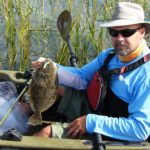
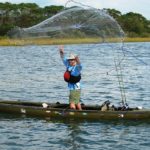
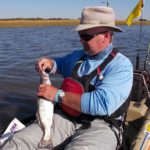
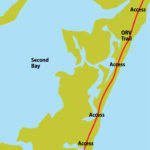




Be the first to comment